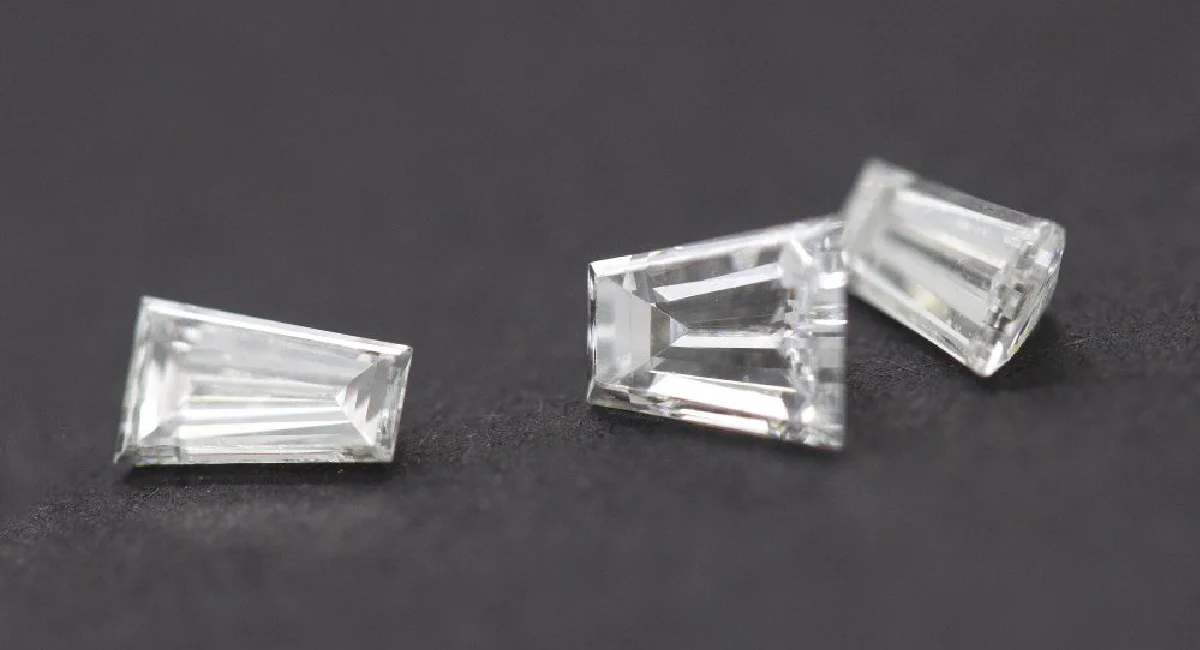In the world of gemstones, few shapes exude the sophistication and historical significance of the baguette diamond. Derived from the French word “baguette,” meaning “little rod” or “stick,” this diamond cut is celebrated for its elongated and slender form. Its sleek, geometric lines have made it a staple in both vintage and contemporary jewelry, embodying a unique blend of elegance and modernity. This article delves into the fascinating history, characteristics and enduring appeal of the baguette diamond, exploring why it remains a beloved choice for jewelry designers and collectors alike.
The Allure of the Baguette Diamond
When it comes to diamonds, the baguette cut stands out for its distinctive shape and understated elegance. Unlike the more traditional round or princess cuts, the baguette diamond offers a streamlined, rectangular form that evokes a sense of timeless sophistication. Its history is deeply rooted in the Art Deco movement of the early 20th century, a period known for its emphasis on clean lines, symmetry, and geometric patterns.
The baguette diamond has a storied past that continues to influence modern jewelry design. Whether set as a central stone or as accent diamonds, baguettes add a touch of vintage charm and architectural beauty to any piece. In this article, we’ll explore the origins of the baguette diamond, its unique characteristics, and how it has maintained its relevance in the ever-evolving world of jewelry.
The Origin of the Baguette Diamond: A Slice of Art Deco History
The Birth of the Baguette Cut
The baguette diamond emerged during the Art Deco era, a time of significant transformation in art, design, and architecture. The Art Deco movement, which began in the 1920s and extended into the 1930s, was characterized by its embrace of modernity, with a focus on geometric shapes, clean lines, and symmetry. This was a departure from the more ornate and intricate designs of the Victorian and Edwardian periods, reflecting a new wave of artistic expression that valued simplicity and order.
It was during this period that the baguette diamond made its debut. The name “baguette” was fitting, as the diamond’s elongated rectangular shape resembled the thin, crispy breadstick of the same name. Jewelry designers quickly embraced this new cut for its ability to complement the bold and structured designs of the Art Deco period. The baguette diamond’s linear form made it ideal for creating intricate patterns, enhancing the overall symmetry and balance of the jewelry pieces.
A Favorite Among Jewelry Designers
The baguette diamond’s rise to popularity can be attributed to its versatility and the way it harmonized with the Art Deco aesthetic. Unlike other diamond cuts that might have overshadowed the overall design, the baguette’s understated elegance allowed it to be used in various ways, from accent stones to centerpieces. This adaptability made it a favorite among jewelry designers who sought to create pieces that were both striking and harmonious.
The baguette cut was particularly popular in engagement rings, bracelets, and brooches of the time. Its ability to reflect light in a subtle, understated way made it a perfect choice for those who desired a sophisticated yet restrained sparkle. Even today, the baguette diamond continues to evoke the glamour and refinement of the Art Deco era, making it a timeless choice for jewelry lovers.
Characteristics of the Baguette Diamond: What Sets It Apart
The Shape and Structure
The defining characteristic of a baguette diamond is its shape: a long, rectangular form with straight edges. Typically, baguette diamonds have 14 facets, which are fewer than those found in more traditional cuts like the round or princess. This gives the baguette a more subdued sparkle, as it reflects light in broad flashes rather than the intense brilliance seen in other cuts.
The baguette diamond can also be found in a “tapered” form, where one end of the diamond is narrower than the other. This variation is often used in designs that require a gradual transition in size or shape, such as in the creation of curved or angled jewelry pieces.
Clarity and Color
Due to its limited number of facets, the baguette diamond does not conceal imperfections as well as cuts with more facets. This makes clarity an important consideration when choosing a baguette diamond. Any inclusions or blemishes are more likely to be visible, so higher clarity grades are often preferred for this cut.
In terms of color, baguette diamonds are usually set in white or platinum settings, which complement their clean lines and enhance their icy appearance. While colorless diamonds are often sought after, the baguette cut can also be used with colored diamonds to create striking, unconventional designs.
The Role of the Baguette Diamond in Jewelry Design
The baguette diamond is often used as an accent stone in jewelry, where it adds a touch of elegance without overpowering the main gemstone. Its linear shape makes it ideal for flanking a larger central diamond or creating intricate patterns within a design. Baguettes are commonly seen in eternity bands, where they are set in a continuous line around the band, symbolizing everlasting love.
In addition to rings, baguette diamonds are frequently used in bracelets, earrings, and necklaces. Their sleek, elongated form can be arranged in various configurations, from simple and understated to elaborate and ornate. Whether used as a single stone or in a cluster, the baguette diamond brings a unique charm to any piece of jewelry.
The Baguette Diamond in Modern Jewelry: A Revival of Vintage Elegance
Contemporary Trends and Applications
In recent years, there has been a resurgence of interest in vintage-inspired jewelry, with the baguette diamond playing a central role in this trend. Modern designers are rediscovering the beauty of this classic cut and incorporating it into contemporary designs that blend old-world charm with new-world innovation.
One popular trend is the use of baguette diamonds in minimalist jewelry, where their clean lines and subtle sparkle are emphasized in simple, elegant settings. This approach highlights the diamond’s natural beauty without the need for excessive ornamentation, appealing to those who appreciate understated luxury.
Celebrity Influence and High-Profile Designs
The baguette diamond has also found favor among celebrities and fashion icons, further fueling its popularity. High-profile engagements and red-carpet appearances featuring baguette diamond jewelry have brought this classic cut back into the spotlight. From engagement rings to statement necklaces, the baguette diamond is once again being celebrated for its timeless elegance and versatility.
Customization and Personalization
Another reason for the renewed interest in baguette diamonds is the growing demand for customized and personalized jewelry. The baguette cut offers a unique canvas for creativity, allowing designers and clients to experiment with different arrangements, settings, and combinations. Whether set in a vintage-inspired piece or a modern minimalist design, the baguette diamond can be tailored to suit individual tastes and preferences.
How to Choose a Baguette Diamond: Tips for Buyers
Understanding Quality and Value
When selecting a baguette diamond, it’s important to consider the quality of the stone, particularly its clarity and cut. As mentioned earlier, baguette diamonds have fewer facets, making inclusions more visible. Therefore, it’s advisable to choose a stone with a higher clarity grade to ensure a clean, flawless appearance.
The cut of the diamond also plays a crucial role in its overall beauty. A well-cut baguette will have precise, sharp edges and a symmetrical shape, enhancing its ability to reflect light. While baguette diamonds are not typically known for their brilliance, a well-cut stone will still exhibit a pleasing, understated sparkle.
Setting and Design Considerations
The setting of a baguette diamond can greatly influence its overall look and feel. When used as an accent stone, baguettes are often set in a channel or bezel setting, which protects the edges of the diamond and creates a seamless, continuous look. For central stones, prong settings are commonly used to showcase the diamond’s shape and allow maximum light to enter the stone.
When choosing a setting, consider the overall design of the piece and how the baguette diamond will complement other elements. Whether it’s a vintage-inspired ring or a modern, minimalist bracelet, the setting should enhance the beauty of the baguette without overshadowing it.
Matching Baguette Diamonds with Other Gemstones
One of the strengths of the baguette diamond is its versatility in design. It pairs beautifully with other gemstones, adding contrast and visual interest to a piece of jewelry. For example, baguette diamonds can be used alongside round or princess-cut diamonds to create a striking juxtaposition of shapes and textures.
Colored gemstones, such as sapphires, emeralds, or rubies, can also be paired with baguette diamonds to create bold, vibrant designs. The clean lines of the baguette cut provide a perfect backdrop for these colored stones, allowing their hues to stand out while maintaining a sense of harmony and balance.
The Enduring Appeal of the Baguette Diamond: A Symbol of Timeless Elegance
Why Baguette Diamonds Remain a Popular Choice
The enduring appeal of the baguette diamond lies in its timeless elegance and versatility. Whether used in vintage-inspired designs or contemporary pieces, the baguette cut offers a unique blend of simplicity and sophistication that resonates with jewelry lovers across generations.
Its ability to complement a wide range of styles and settings makes the baguette diamond a popular choice for those seeking a distinctive yet understated gemstone. Whether as an accent stone or a central feature, the baguette diamond continues to captivate with its clean lines and refined beauty.
The Future of Baguette Diamonds in Jewelry Design
As the jewelry industry continues to evolve, the baguette diamond is likely to maintain its place as a beloved and enduring symbol of elegance. With a growing interest in vintage-inspired designs and a renewed appreciation for classic cuts, the baguette diamond is poised to remain a staple in both high-end and everyday jewelry.
Designers are continually finding new ways to incorporate baguette diamonds into their collections, exploring innovative settings, and combinations that highlight the cut’s unique characteristics. As a result, the baguette diamond will continue to inspire and delight jewelry enthusiasts for years to come.
Conclusion
In a world of ever-changing trends, the baguette diamon’d stands as a testament to the enduring appeal of classic design. Its clean lines, understated elegance, and historical significance make it a timeless choice for jewelry lovers and collectors alike. Whether you’re drawn to the vintage charm of Art Deco designs or the sleek sophistication of modern jewelry, the baguette diamon’d offers a unique and versatile option that will never go out of style.
From its origins in the glamorous world of the 1920s to its resurgence in contemporary fashion, the baguette diamond continues to captivate with its elegance and beauty. As you explore the world of jewelry, consider the baguette diamond as a symbol of timeless sophistication and a piece of history that you can wear every day.







